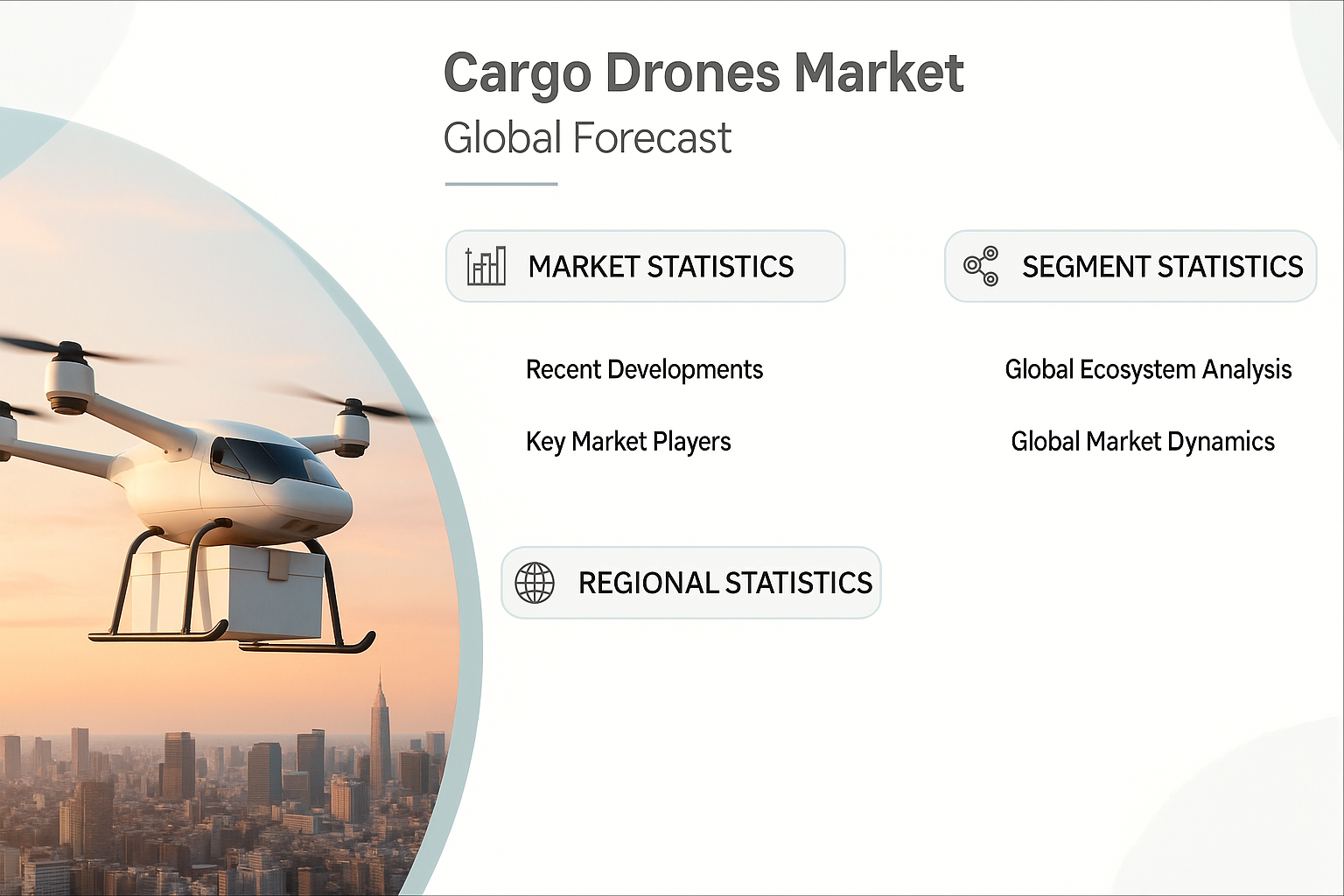AI Impact Analysis on Cargo Drones Industry
Cargo Drones Market and AI Integration
The cargo drones market is experiencing a significant transformation as artificial intelligence (AI) becomes increasingly integrated into various aspects of drone operations. From enhancing autonomous navigation to optimizing logistics and maintenance, AI is playing a pivotal role in advancing the capabilities and efficiency of cargo drones. This integration is not only improving operational performance but also opening new avenues for commercial applications across industries.
AI in Autonomous Navigation of Cargo Drones
AI is revolutionizing the way cargo drones navigate by enabling real-time route optimization and terrain-aware obstacle avoidance. Through machine learning algorithms, drones can adapt to GPS-independent navigation, ensuring precise delivery even in challenging environments. Self-learning navigation systems allow drones to improve their flight paths over time, while weather-adaptive flight planning ensures safety and reliability. AI also enhances landing precision and provides redundancy in navigation decisions, integrating seamlessly with urban air mobility frameworks and facilitating emergency rerouting when necessary.
Predictive Maintenance Using AI
Implementing AI in predictive maintenance allows for continuous monitoring of drone health data, enabling the prediction of mechanical failures before they occur. Real-time diagnostics during flight help in reducing downtime and optimizing battery performance. Machine learning models can forecast wear and tear, schedule maintenance alerts, and analyze component-level lifecycle, leading to efficient spare parts management and optimized inspection intervals.

AI in Cargo Load Management
AI enhances cargo load management by dynamically balancing loads and monitoring real-time weight distribution. It ensures payload security through continuous monitoring and adapts the cargo hold environment based on the nature of the goods. AI algorithms adjust the center of gravity, scan smart containers, and track loads using sensors, detecting anomalies and optimizing fuel or energy usage. Integration with warehouse AI systems further streamlines the logistics process.
Route Planning and Traffic Management
AI facilitates real-time airspace monitoring and urban air traffic coordination, dynamically updating geofencing parameters. It enables multi-drone coordination, minimizes energy consumption, and ensures compliance with restricted areas. AI-driven altitude adjustments and optimized corridor routing help in forecasting high-traffic zones and integrating seamlessly with air traffic control systems.
AI for Real-Time Obstacle Detection and Avoidance
Utilizing AI, cargo drones can interpret Lidar data for obstacle detection and employ neural networks for object recognition. This capability allows for the identification of birds, aircraft, trees, and buildings, enhancing drone swarm coordination and spatial awareness. AI also aids in detecting adverse weather conditions, learning new obstacle types, and making real-time response decisions, ensuring 360-degree situational awareness.
Get AI Impact Analysis on Cargo Drones Market, Request Pdf Brochure: https://www.marketsandmarkets.com/pdfdownloadNew.asp?id=252936360
Security and Surveillance via AI
AI strengthens security measures by verifying package integrity and detecting tampering through vision systems. It enables real-time threat detection, facial and object recognition, and flight deviation alerts. AI-powered cybersecurity measures prevent drone hijacking, encrypt communications, and detect intrusions, while smart camera surveillance monitors cargo during transit.
AI in Fleet Management
AI optimizes fleet management through intelligent dispatch scheduling and predictive analytics for fleet usage. It forecasts drone availability, optimizes maintenance rotations, and analyzes delivery performance. AI facilitates autonomous drone-to-drone coordination, models fleet behavior, minimizes downtime, and reduces route overlaps, enhancing overall operational efficiency.
Regulatory Compliance and AI Automation
AI ensures regulatory compliance by automatically updating no-fly zones and adapting to real-time regulations. It verifies compliance through algorithms, documents flight logs, and manages transponders. AI adjusts missions based on regulations, creates audit trails, ensures privacy compliance during flights, and automates emergency landing procedures, streamlining insurance processing.
AI Integration with Logistics and Supply Chain
Integrating AI with logistics and supply chains allows for real-time inventory synchronization and accurate delivery time forecasting. AI coordinates intelligent pickups and drops, integrates with warehouse robotics, and syncs routes with delivery trucks. It optimizes hub-and-spoke planning, automates customs documentation, enhances package sorting, schedules deliveries with ERP systems, and prioritizes deliveries based on urgency.
Future Trends: AI and Next-Gen Cargo Drones
Looking ahead, AI is set to drive future trends in cargo drones, including the use of quantum AI for predictive logistics and the deployment of drone swarms. Human-AI collaboration will enhance logistics, while AI will support Beyond Visual Line of Sight (BVLOS) operations. The integration of 5G/6G networks will empower AI decision-making, enabling vertical takeoff for heavy cargo, edge AI for remote deliveries, self-charging docking systems, intermodal logistics, and scalable AI-driven drone networks.
The AI-Driven Future of the Cargo Drones Market
As we progress through 2025, the fusion of AI and cargo drones is revolutionizing the logistics landscape. AI enhances navigation, maintenance, load management, and regulatory compliance, making cargo drones more efficient and reliable. This synergy is not only transforming current operations but also paving the way for innovative applications and expanded capabilities in the future.
Related Report:
Cargo Drones Market by Solution (Avionics, Route Planning & Optimization, Ground Control Stations, Service), Industry (Retail, Healthcare, Agriculture, Maritime, Defense), Range (Short, Mid, Long), Type, Payload, and Region - Global Forecast to 2030
This FREE sample includes market data points, ranging from trend analyses to market estimates & forecasts. See for yourself.
SEND ME A FREE SAMPLE





